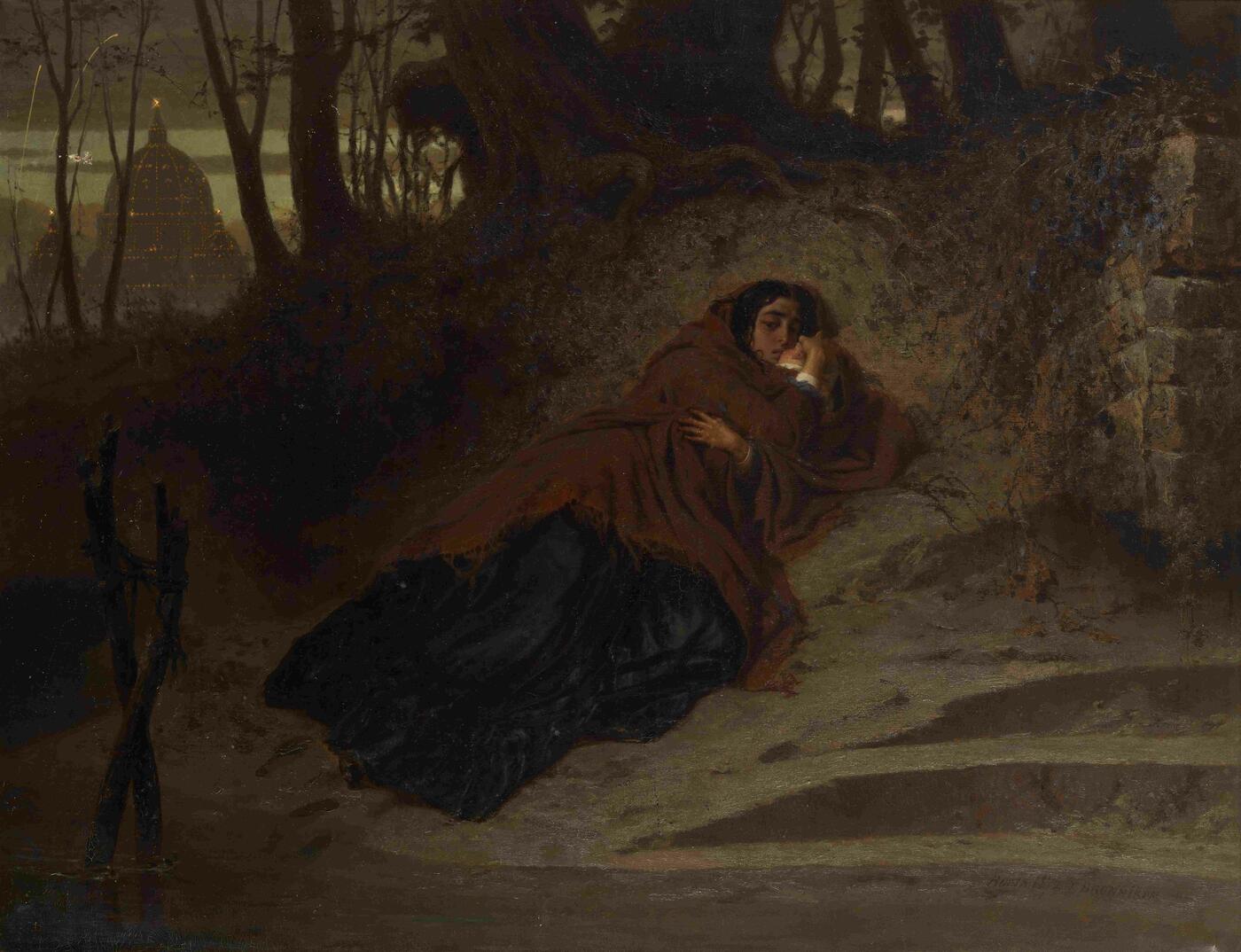MacDougall's Russian Art Auctions 1-2 Dec 2010
1 December 2010

394. BRONNIKOV, FEODOR 1827-1902
Abandoned. The Vatican and Sin signed, inscribed "Rome" and dated 1872
Oil on canvas, 88 by 114 cm.
190,000-250,000 GBP
Authenticity has been confirmed by the expert V. Petrov.
The picture Abandoned. The Vatican and Sin is an autograph copy of one of the best-known compositions of Feodor Bronnikov, a history painter popular in the last third of the 19th century.
Painted in Rome in 1872, it is a splendid example of the genre based on themes relating to the Eternal City. Bronnikov, following the classical canons, composes his painting like a stage set, on which he places his heroine in a striking and expressive position. The artist, always scrupulously accurate in his handling of detail, meticulously delineates the masonry of the parapet, the flare of distant fireworks, the ring on the heroine’s finger and her white cuffs. Beneath a surface restraint and sobriety in the portrayal, much is hidden in this painting, stemming from the contrast at the heart of this dramatic situation.
Both in the technique used and in the treatment of the subject, we can detect a curious fusion of the academic tradition with the aesthetics and themes of the Itinerants. For when Bronnikov graduated from the Imperial Academy of Arts, he left Russia in 1854 on a study placement and then spent the rest of his life in Rome, rarely visiting Russia. Only in 1863 did he travel to St Petersburg, to present to the selection board of the Academy a large painting on a subject from Roman history, The Quaestor Reading the Death Sentence to Senator Thrasea Paetus for which he was named Professor of history painting.
However, having arrived in Russia via an academic route, Bronnikov was quick to pick up new "populist" tendencies in the art of his native land. The artist became close to the Itinerants and, under their influence, felt an urge to do social good via his art. In his paintings a taste became apparent for portraying life in the lower strata of society, for themes and motifs "laying bare the festering sores of contemporary life". But unlike the Russian colleagues in his studio, Roman sybarite Bronnikov had lost his basis in Russian life and could not develop such themes, instead settling for "Italian" subjects. So he painted a series of genre pictures: Poor Family Being Driven from Their Lodging, An Old Beggar, Golden Wedding Anniversary, Distribution of Food in Front of the Monastery Gates, Sick Man Outside a Catholic Monastery, Artists in a Rich Man’s Parlour and Abandoned. The Russian critics, understandably, thought that Bronnikov belonged "to the earlier, 'idealist' school, which holds back this artist, a sincere lover of justice, from portraying the unsavoury traits of his subject". But it was precisely that academic prettiness and a certain pathos and sentimentality, not at all detrimental to an understanding of the "unsavoury position" of his heroes, which allowed Bronnikov to create his own type of genre painting "on the topics of the day".
Soon Bronnikov was admitted to the Society of Itinerant Art Exhibitions. From 1873 he showed his works at exhibitions in Moscow, St Petersburg, Kiev etc, alongside the greatest Russian masters. Bronnikov even painted an autograph copy of our painting, Abandoned. The Vatican and Sin, dated 1873, specially for the Society’s third exhibition. Reproduced in the exhibition catalogue, it made a great impression on his contemporaries and was soon bought by the mayor of Irkutsk, Vladimir Platonovich Sukachev. It is now housed in the Irkutsk Museum of Art which bears his name.
As for the present, earlier version of this composition, its history is most probably associated with art collections in the West. At least, according to the Brockhaus and Efron Encyclopaedic Dictionary, "most of Bronnikov’s works are in Russia, but many have also been acquired by connoisseurs in England, America, Hungary, Italy and Denmark. Among his last works, Abandoned is worthy of note. This painting is owned by the Queen of Denmark".
Notes on symbols:
* Indicates 5% Import Duty Charge applies.
Ω Indicates 20% Import Duty Charge applies.
§ Indicates Artist's Resale Right applies.
† Indicates Standard VAT scheme applies, and the rate of 20% VAT will be charged on both hammer price and premium.